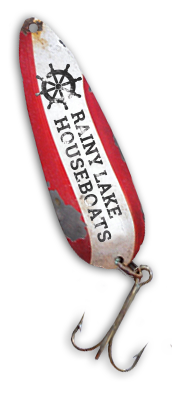Pete’s trip marks the first fly fishing only trip of the year. Bill Dougherty, Jon Balaski and Kevin Erickson were the guides. We fish strictly smallmouth bass with accidental pike thrown in. This year we were hoping to target bedded smallmouth bass on Pete’s trip. On the previous trip we had seen a few bass nests but not many. Our Guide boats are Lund Pro V GL208 with a with a 250 hp Mercury, Lund Pro V GL197 with a 225 hp Mercury Verado, and a Lund 2025 Pro V IFS with a 250 HP Suzuki.
On Tuesday Pete Ankeny, Chuck Moos, Ben Case and Steve Johnson caught about 35 very nice smallmouth casting Murray popping bugs and a form of wooly bugger called a tequillia.
Wednesday smallmouth bass started to bed heavily on shallow south facing shores. At times bass milling around the nests surrounded the boats. They had no interest in feeding. They wanted to spawn but water temperature or some other phenomenon was holding them up. Further down the shore bass started to hit surface poppers. Sometimes it was a slow rise to the fly and a subtle sucking the fly under; other times it was a hard smack. During the afternoon the bass seemed to leave the spawning nests and moved very tight to shore. The water level is about 1 ½ ft. higher than normal. This makes the nests deeper and harder to see and at the same time allows bass to get quite close to the shoreline edge.
Thursday smallies cooperated really well taking poppers off the surface in nesting areas. More nests were showing up as the day went on. Even though bass were on or very near the nests they had not spawned and were not guarding the nest with their normal ferocious attitudes.
Every year is different in the life of a Rainy Lake smallmouth. They are not native to Rainy Lake. They were introduced in the early 1900’s. Smallmouth have the hardest time spawning of all the different species. They need certain water temperatures, bottom content that has rock, sand, and gravel. Unlike other fish in the lake the female smallmouth only mates with one male, not multiple males. After spawning the male stays on the nest fanning the nest and protecting it from minnows, crayfish or any other threats. Eggs hatch in 3-10 days normally the longer the time period the more stressful on the male smallmouth.
Another successful trip was had; it was different in the respect that the bass were around nests but not actually spawning. It is probably happening today and tomorrow. We will be back for more fly-fishing on Thursday. We leave this afternoon on a walleye trip.

